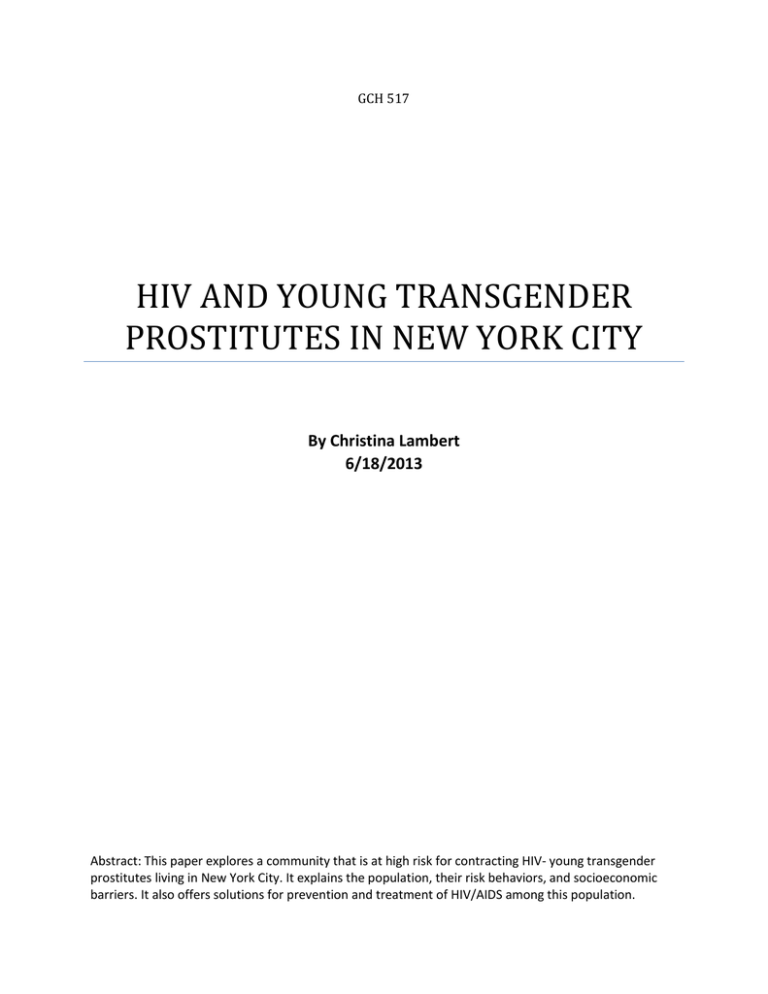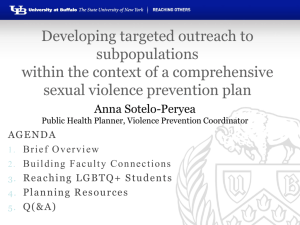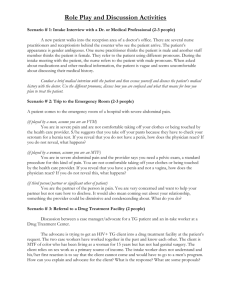
GCH 517
HIV AND YOUNG TRANSGENDER
PROSTITUTES IN NEW YORK CITY
By Christina Lambert
6/18/2013
Abstract: This paper explores a community that is at high risk for contracting HIV- young transgender
prostitutes living in New York City. It explains the population, their risk behaviors, and socioeconomic
barriers. It also offers solutions for prevention and treatment of HIV/AIDS among this population.
HIV AND TRANSGENDER PROSTITUTES
In 1981, a health crisis broke out. Human Immunodeficiency Virus (HIV) was first
discovered among a few men in California. These were homosexual men, and it was believed
that the new disease would not affect anyone outside of this population. However, the epidemic
grew. More populations became affected and more people died. Scientists scrambled to find a
cure as people became infected and dropped dead after HIV developed into Auto Immune
Deficiency Syndrome (AIDS). It has been over 30 years, and although progress has been made,
HIV/AIDS still prevails.
Today, there are medications called antiretrovirals that can be taken to slow down the
progress of the disease. There are methods of prevention, such as using condoms and clean
needles. Despite this progress, not everyone is equally protected from HIV/AIDS. Certain
minority populations are at an elevated risk of contracting the disease, and exclusion and stigma
stands in the way of their health. Young transgender prostitutes living in New York City (NYC)
are an example.
Prostitutes engage in many types of sexual activities, including anal, vaginal, and oral
sex. They do this with many partners, and this is can transmit HIV. Condoms can be used to
prevent the transmission of HIV, but prostitutes are not always given the option of using them,
depending on what their partner asks. This makes prostitutes highly susceptible to contracting
HIV and passing it along to a partner, as well as other Sexually Transmitted Infections (STIs)
and Sexually Transmitted Disease (STDs).1 Aside from prevention, treatment is also very
important. There are clinics where one can be tested for HIV/AIDS, and there are antiretroviral
medications if one tests positive. However, prostitutes may not have the money or the mobility to
visit a doctor to be tested or to receive treatment for diseases, which puts them at an even greater
risk for becoming more ill.
1
Laga, M. & Piot, P. (1988). Retrieved from http://www.ncbi.nlm.nih.gov/pubmed/3066058
HIV AND TRANSGENDER PROSTITUTES
Young prostitutes are especially vulnerable because they do not have as many resources
as older people. Many young prostitutes are runaways or high school dropouts who have no other
means of income and must resort to this high-risk lifestyle, and people between the ages of 16-25
are already at an elevated risk for contracting STIs and STDs.2 This makes young prostitutes a
double risk category. Prostitutes in highly-populated urban areas are at an even higher risk of
contracting disease, because HIV is more prevalent in urban areas.3 NYC, the most populated
area in the United States (US), is an especially risky area for prostitutes to be working. Due to
the sheer volume of people, prostitutes are more likely to engage in unprotected sexual contact
than in a sparsely populated area.
Young prostitutes in urban areas are at a high risk as it is, but transgender prostitutes are
extremely vulnerable. The transgender population is another at-risk but highly stigmatized group.
Many transgender people are misunderstood, so some basic definitions need to be explained. The
term gender identity refers to a person’s basic sense of self, of identifying as male, female, or
some other gender (transgender, intersex, etc). Transgender refers to people whose gender
identity does not match their sex assigned at birth. It includes people who self-identify as maleto-female (MTF) or transgender women, female-to-male (FTM) or transgender men, and others.
Gender identity and sexual orientation are separate, and are not linked to one’s physical anatomy.
This can be confusing to some, and because of this the transgender population is misunderstood
and ostracized. Transgender prostitutes are particularly at risk for HIV/AIDS due to stigma and
risky sexual behaviors.
2
Edinburgh, L & Saewyc, E. (2010, May 21). Retrieved from
http://www.ncbi.nlm.nih.gov/pmc/articles/PMC2874576
3
Baker, L., Case, P., & Policicchio, D. (January 2003). Retrieved from
http://www.ncbi.nlm.nih.gov/pmc/articles/PMC141189
HIV AND TRANSGENDER PROSTITUTES
Because data for transgender people are not uniformly collected, there is not very much
information on how many transgender people in the US are infected with HIV. There is some
data from the Centers for Disease Control and Prevention that show high percentages of newly
identified HIV infections among transgender people. In 2009, about 4,100 of 2.6 million HIV
testing events were conducted with someone who identified as transgender, and newly identified
HIV infection was 2.6% among transgender persons compared with 0.9% for males and 0.3% for
females.4 It was found that in NYC, there were 206 new diagnoses of HIV infection among
transgender people between 2005 and 2009, 95% of which were among transgender women.5
Also, newly diagnosed transgender people were more likely to have been in their teens or
twenties than their non-transgender counterparts, and among newly diagnosed people, 50% of
transgender women had documentation in their medical records of substance use, commercial
sex work, homelessness, incarceration, and/or sexual abuse as compared with 31% of other
people who were not transgender.6
As far as testing goes, findings from studies showed that 27.7% of transgender women
tested positive for HIV infection, but when testing was not part of the study, only 11.8% of
transgender women self-reported having HIV, and in one study, 73% of the transgender women
who tested HIV-positive were unaware of their status.7 This is a huge problem- being unaware of
your status is dangerous because of the risk of passing HIV on to a partner. The discrepancies
between those who actually tested positive and those who self-reported are particularly alarming,
because many people think they are safe or not at risk when the exact opposite is true.
4
US Centers for Disease Control and Prevention, www.cdc.gov, accessed June 17, 2013.
US Centers for Disease Control and Prevention, www.cdc.gov, accessed June 17, 2013.
6
US Centers for Disease Control and Prevention, www.cdc.gov, accessed June 17, 2013.
7
US Centers for Disease Control and Prevention, www.cdc.gov, accessed June 17, 2013.
5
HIV AND TRANSGENDER PROSTITUTES
One way to slow the transmission of HIV in this population (and in all populations for
that matter) is prevention. This is not a simple task, as many challenges exist. Identifying
transgender people is one of them. Using gender alone is not enough because some people in this
community do not self-identify as transgender. Asking people for their sex assigned at birth and
their current gender can help correctly identify transgender people. There is great diversity in this
population; for example, some people identify as both transgender and gay, bisexual, or lesbian.
Because of this, it is important to avoid making assumptions about sexual orientation and sexual
preferences based on gender identity alone.
Unfortunately, not everyone is aware or even tolerant of this. Discrimination and social
stigma can hinder access to education, employment, and housing opportunities, and
environmental factors like economic difficulties can lead to more high-risk activities, including
commercial sex work like prostitution, to survive.8 This leads to unprotected sexual intercourse
with multiple partners and therefore an increased risk of contracting HIV. Ending stigma is not
an easy task, however, so a focus must be placed on intervention for young transgender
prostitutes so they can learn to protect themselves.
There are ways to help stop the spread of HIV. Accurate and up-to-date information must
be available to all. The health needs of the transgender population must be addressed and gaps in
health services must be filled to accommodate those in minority populations. The CDC is
revising the national system for reporting HIV cases to record sex assigned at birth and current
gender identity, and this will improve the likelihood of accurately identifying diagnoses of HIV
infection among transgender people.9 In addition, the CDC is developing an HIV-related
behavioral survey to monitor current HIV-related risk behaviors and prevention experiences
8
Hwahng, J. & Nuttbrock, L. (2007, December 4). Retrieved from
http://www.ncbi.nlm.nih.gov/pmc/articles/PMC2597809
9
US Centers for Disease Control and Prevention, www.cdc.gov, accessed June 17, 2013.
HIV AND TRANSGENDER PROSTITUTES
among transgender women.10 Even though this behavioral survey does not include men, it is a
good start. Risk behaviors among transgender women may be similar to transgender men, so
identifying these can help form an intervention program for men.
There are not many HIV prevention interventions for the transgender community, so the
CDC has funded interventions for transgender people.11 These interventions can help prevent
those in the transgender community from engaging in risky behaviors. Also, the CDC has funded
organizations to adapt these HIV prevention interventions for use with transgender people.
Funding organizations to do this will mean the prevention interventions reach more people, and
the more people know about HIV prevention, the more HIV can be prevented. The CDC has
helped community-based organizations that serve transgender people to improve interventions
such as condom distribution, community mobilization, HIV testing, and coordinated referral
networks.12 These resources can effectively prevent the spread of HIV.
It is important to understand that more research is needed to identify factors that prevent
HIV in young transgender prostitutes in a populated area such as NYC. HIV prevention
interventions developed for transgender people have been reported, usually with small samples
of mostly transgender women, and have shown modest reductions in HIV risk behaviors, such as
fewer sex partners and/or reducing unprotected sex, although none have involved a control
group.13 If more of these can be implemented, then reductions in HIV risk behaviors can
continue.
10
US Centers for Disease Control and Prevention, www.cdc.gov, accessed June 17, 2013.
US Centers for Disease Control and Prevention, www.cdc.gov, accessed June 17, 2013.
12
Effective Interventions,
http://www.effectiveinterventions.org/en/HighImpactPrevention/StructuralInterventions/CondomDistribution.asp
x , accessed June 17, 2013.
13
US Centers for Disease Control and Prevention, www.cdc.gov, accessed June 17, 2013.
11
HIV AND TRANSGENDER PROSTITUTES
In the US, the adult prevalence rate of HIV/AIDS was 0.6% in 2009.14 This can be
defined as the percentage of adults (aged 15 -49) living with HIV/AIDS. The adult
prevalence rate is calculated by dividing the estimated number of adults living with
HIV/AIDS at year end by the total adult population at year end. The numerical
amount of people living with HIV/AIDS in 2009 was estimated at 1.2 million, and
this is the ninth largest total in the world! 15 The US is a developed nation, one of
the most advanced in the world, yet it still made it in to the rank of top 10 of nations
with the most citizens infected with HIV/AIDS. It is nestled in with mostly povertystricken African nations, such as South Africa and Zimbabwe. In the same year,
17,000 people died of AIDS, making the US number 18 in the world. 16 These figures
should demonstrate the urgency to prevent HIV from infecting more people.
This begs the question, how can such a modern country be plagued by such a
devastating disease? Not all groups are equally accepted by society, even though the
US preaches equality. Groups like transgender prostitutes continue to face stigma
and continue to lack access to prevention, treatment, and education about HIV.
They may be separated from the help they need by lack of mobility , funds, or lack
an understanding health care provider. Those who are young and who work in urban
areas are especially vulnerable. This population needs special care when it comes to
HIV prevention, and more needs to be done to reach out to this population . This
needs to be addressed immediately by health experts if the US wants to defeat
HIV/AIDS.
14
The CIA World Factbook, https://www.cia.gov/library/publications/the-world-factbook, accessed June 17, 2013.
The CIA World Factbook, https://www.cia.gov/library/publications/the-world-factbook, accessed June 17, 2013.
16
The CIA World Factbook, https://www.cia.gov/library/publications/the-world-factbook, accessed June 17, 2013.
15
HIV AND TRANSGENDER PROSTITUTES
References
CIA World Factbook, https://www.cia.gov/library/publications/the-world-factbook
Baker, L., Case, P., & Policicchio, D. (January 2003). Retrieved from
http://www.ncbi.nlm.nih.gov/pmc/articles/PMC141189
Edinburgh, L & Saewyc, E. (2010, May 21). Retrieved from
http://www.ncbi.nlm.nih.gov/pmc/articles/PMC2874576
Effective Interventions,
http://www.effectiveinterventions.org/en/HighImpactPrevention/StructuralInterventions/Condom
Distribution.aspx
Hwahng, J. & Nuttbrock, L. (2007, December 4). Retrieved from
http://www.ncbi.nlm.nih.gov/pmc/articles/PMC2597809
United States Centers for Disease Control and Prevention, www.cdc.gov




